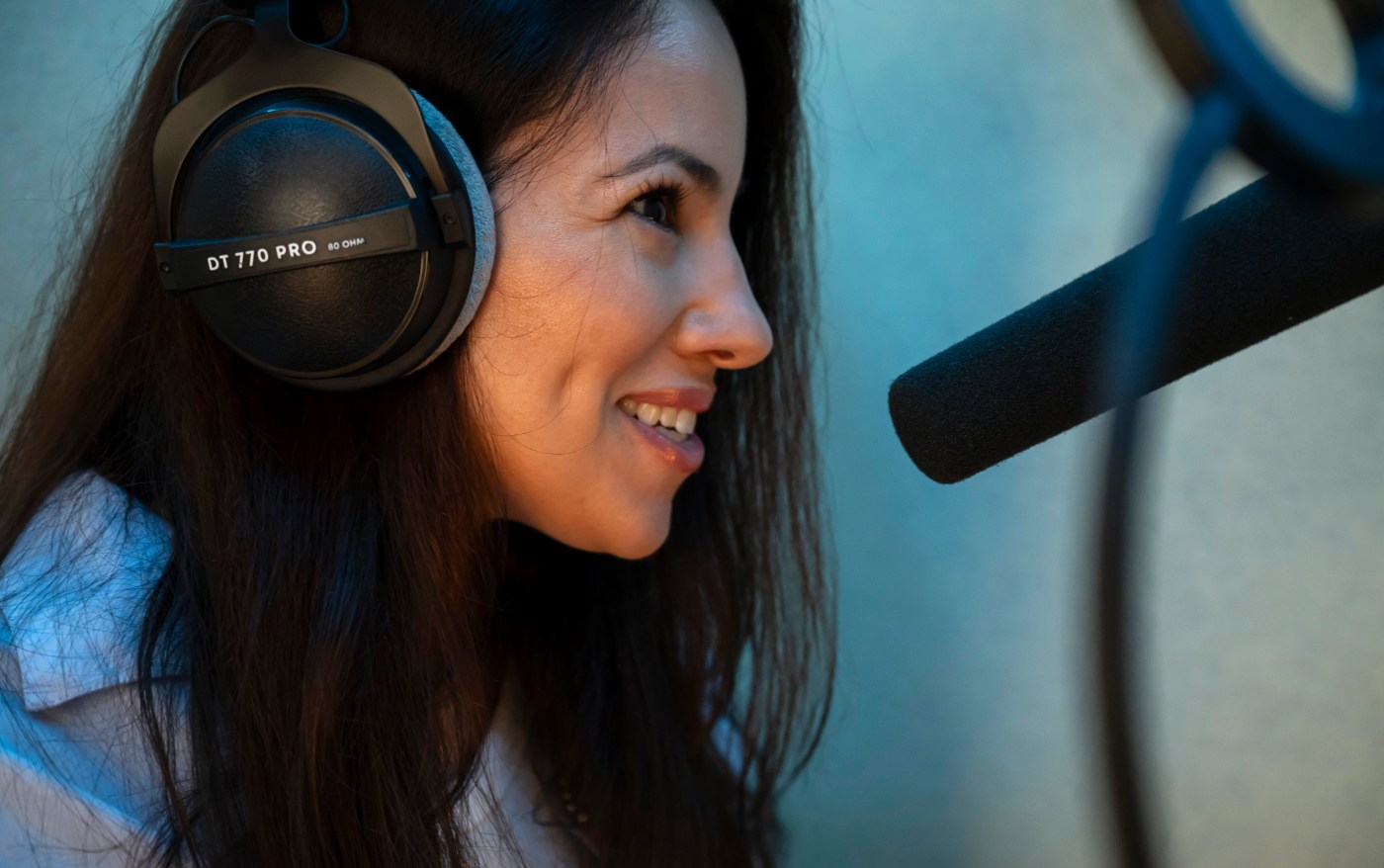
A car crash compelled a Fox 9 reporter to pursue a career as a ‘voice artist’
Voice-over artist Iris Pérez records audio for a commercial in a sound booth in her Minneapolis-area home on Tuesday, April 15, 2025. Pérez spent 14 years in television news but left in 2021 to focus full-time on voice-over work for a wide variety of corporate and nonprofit clients. (John Autey / Pioneer Press)
“I told them I was suffering, and they listened,” the faceless female voice said in Spanish brimming with emotion. “No judgments. Only help.”
The web and social-media spot for the 988 Suicide and Crisis Lifeline is intended to save lives. The people reading the script — there is also a male voice speaking Spanish — are therefore recruited based on the influence they can project.
This is an example of powerful “voice over” work that has drawn talent such as Iris Pérez, who was until 2021 a reporter and fill-in anchor at Fox 9 in the Twin Cities.
“Anywhere you hear a voice but don’t see the face, that’s voice over,” said Celia Siegel, a Minneapolis-based business coach and manager of voice artists such as Pérez.
Pérez is the female voice in the Línea 988 de prevención del suicidio y crisis spot. In a hyper-competitive field, she has also done work for Pfizer pharmaceuticals, Merrell footwear, Nutramegin infant formula, Skinceuticals skin-care products, and Bacardí liquor.
Now a voice-over pro, she identifies with the 988 job because she has seen her own kind of suffering — one that has opened the doors to a new career, but brought pain along the way.
It started in August 2018, when she and Fox 9 photojournalist Seraj Sarim were rear-ended on the way to a reporting assignment.
“I remember hearing a loud thud and gasping as I felt the wind knocked out of me. I was in a haze and felt confused,” she said. “I asked, ‘Were we just hit?’ ‘Yeah,’ Sarim said, grabbing the front of his head.”
Medical recovery proved challenging.
“I’d been pushing through what was diagnosed as a ‘mild concussion’ and I had a rough time getting better,” she said. “I (kept) a grueling schedule — physical therapy, neurology appointments, and relentless workdays — before discovering I actually had a moderate TBI (traumatic brain injury). That stalled my recovery.”
Stepping away from journalism
Ultimately, she decided to prioritize health and step away from journalism. She weighed becoming a medical interpreter, a yoga instructor and a media analyst before picking the voice-over profession as her new calling — her company is called Soulful VO — amid lingering medical symptoms.
“For as long as I can remember, I’ve loved voice over,” said Pérez, who lives in the Minneapolis suburbs. “After all, it was a part of my everyday life in news.” Adding narration to video in news is called “tracking” or “voicing.”
“My voice is actually what viewers would compliment me on the most,” Pérez said. “I never took that acknowledgement or appreciation for granted.”
Voice-over artist Iris Pérez in her miniature sound studio in the office of her Minneapolis-area home on Tuesday, April 15, 2025. Pérez, who received a moderate TBI (traumatic brain injury) in an Aug. 2018 car crash, left television news to pursue the voice-over profession as her new calling amid lingering medical symptoms. (John Autey / Pioneer Press)
Pérez, a Detroit native of Puerto Rican extraction, does voice-over work just as naturally in Spanish as in English. (Demos in both languages are on her website at soulfulvo.com.)
“Thank goodness for wise Puerto Rican mamas who tell their children, en la casa, español (at home, Spanish),” she said. “Much is the case in English. Having grown up in inner-city Detroit, I offer a range that can be felt on the street, at the luxury car dealer, el campo (the countryside) or a major market newsroom.”
‘Needed to un-news her’
Pérez’s voice-over cadence initially needed work, said Dave Walsh, her voiceover coach.
“If you watch newscasts, there’s a very uniform way that they speak,” said Walsh. “It’s not good or bad, it’s just the world of news. So with Iris having done a lot of news reporting, I needed to un-news her a bit and get her to speak more naturally.”
Voice-over technology was another, larger barrier for her.
“There’s a lot of front-loading involved. You’re buying yourself a pretty expensive job,” she said. “People don’t usually tell you that. But if you do your vetting, you quickly find that out.”
Top-flight gear is essential because auditions rarely occur at client sites these days. It’s all done from the voice artist’s own location.
“If you didn’t have a home studio by the time COVID hit, you were kind of out of luck because agents couldn’t have you in their offices,” Walsh said. “Most auditions were being done from home at that point, and that put a nail in the coffin for in-person auditions.”
Iris Pérez records audio for a commercial in a miniature sound studio in her Minneapolis-area home. (John Autey / Pioneer Press)
Pérez’s toolkit includes a Sennheiser MKH 416 shotgun microphone and an Apollo Solo audio interface connected to her MacBook Air laptop, which runs Adobe Audition software.
Most dramatic is her LA Vocal Booth, a soundproof hut of sorts sitting in the middle of her apartment and costing thousands. “It’s a serious home studio upgrade,” a premium model with high end acoustic panels, that she bought with an Elevate Together small-business grant from the National Urban League, the U.S. Hispanic Chamber of Commerce and Office Depot, she said.
“What shall we name her?” Pérez excitedly asked, regarding the recently arrived booth.
A different microphone
Reintroducing herself to the Twin Cities community has been “especially fulfilling,” she said.
Related Articles
Eagan native Eva Erickson thanks her ‘hockey legs’ for ‘Survivor’ wins
Records show Gene Hackman’s wife researched symptoms of illness days before her death
Blue Origin launches an all-female celebrity crew with Katy Perry, Gayle King and Lauren Sanchez
Author, wife of Weezer bassist arrested after being shot by police who say she pointed a gun at them
British police charge comedian Russell Brand with rape and sexual assault
She says she’s been “pleasantly surprised by how many folks recognized me, asked what I’m up to now, and how they can support.”
“It means the world to me that my work as a journalist isn’t forgotten and means something, even all these years later,” she said. “It makes me really proud to continue representing communities of color — I’m just behind a different microphone now.”
Still suffering from TBI symptoms, she is especially mindful of finding opportunities to help women of color “who are faced with sudden disruptions to their careers due to chronic conditions outside their control — as I was,” she said. “This may be just as, if not more, important than anything I do behind a mic.”


